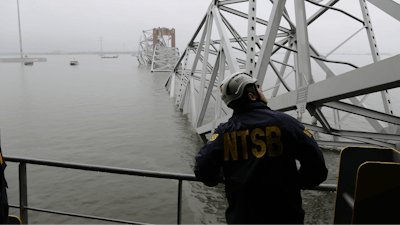
Early Tuesday morning, the cargo vessel Dali smashed into the Francis Scott Key Bridge in Baltimore, triggering a deadly collapse. Six construction workers who were filling potholes on the bridge at the time of the accident are presumed dead, and the incident has the engineering community on high alert as it strives to prevent future tragedies.
The faculty at Johns Hopkins University, whose flagship campus is located on the city's north side, felt a deep connection to the event. On Wednesday, four of the university's civil and systems engineering and business analytics experts held a media briefing to discuss the collapse, and the broader implications stemming from it.
Ben Schafer, a structural engineer and civil and systems engineering professor, doesn't view the incident as a bridge collapse, but rather a bridge that was destroyed in an "infrastructure system failure."
"It's a complicated system that includes the port, the shipping that was going underneath the bridge on a daily basis, and then the failure event related to things that happened on the ship in addition to what happened when it hit the bridge," Schafer said.
The Francis Scott Key Bridge is an iconic Baltimore structure, said Rachel Sangree, an associate teaching professor in the engineering department. While it was a catastrophic collapse, she added that it wasn't surprising given the vessel's size in comparison to the bridge piers — the sections of the bridge that connect the structure to the footings or foundation. Piers are concrete supports that handle the bridge's load.
"Unfortunately, these sorts of tragedies often do result in a better understanding of how to move forward and in designing our infrastructure systems," Sangree said. "They are also reminders of the importance of continuous investment in our infrastructure systems — not just in the bridge itself, but this is a complex, interconnected couple of systems that are coming together under this bridge."
The National Transportation Safety Board (NTSB) is investigating the events contributing to the accident.
Bridge Defense Systems
Susu Xu is an assistant professor who focuses on smart infrastructure systems and rapid disaster response. She believes there are many areas that government regulators and fellow engineers and researchers need to be reviewing very carefully, but two, in particular, merit increased scrutiny: the fender systems that are designed to protect bridges, and the ship's early warning system. Fender systems are located near the base of the pier and are intended to deflect errant ships from striking the piers.
"We need to investigate how we need to reinforce fender systems to protect bridge piers, especially given the very huge impact forces induced by these large cargo vessels," Xu said. She stressed that regulators must also make sure that onboard warning systems are correctly operating, so they can alert people to evacuate in a timely manner. Xu said these systems are designed to be installed on the bridge to predict possible ship collisions and alert people once a potential crash is imminent. According to the NTSB, local police had a 90-second warning to try and get people off the bridge after they received a distress call.
Schafer said that the Key Bridge did have some protection at the bottom of the bridge, but characterized it as pretty modest. It was capable of stopping a small fishing vessel but not a cargo ship. The Dali's bow was also much higher than the protection; the cargo ship was simply too tall.
Schafer, however, noted that creating a pier protection system capable of withstanding a straight-on blow isn't economically feasible. While structurally possible, it would be too costly. Rather than building piers to stand up to such a force, he stressed the importance of being able to divert the ship away from the pier — with enough time and distance so that the ship's energy could dissipate before impact.
"Could we build a Fort Knox in front of every bridge? It's structurally possible, but it's not economically feasible," Schafer said. He remains unconvinced that even the most extreme bridge protection systems would be successful in a similar collision.
Sangree added that redirection might not work either, since, given the size of the vessel, it might just redirect the ship into another pier.
Logistical Concerns
Schafer predicted that it will likely take weeks, if not months, to remove bridge debris and reopen the shipping channel, but likely less than a year. However, he suggested that it will take years to rebuild the bridge and transportation network entirely. Schafer said it took five years to build the original bridge, and that nowadays, that type of project rarely takes less than 10 — and that the price tag would be in the hundreds of millions of dollars.
Tinglong Dai, a professor at the Johns Hopkins Carey Business School with a specialty in operations management and business analytics, said that the Port of Baltimore is essential for the automotive supply chain, but that the closure would overall have a relatively minor, short-term impact. The port specializes in truck imports and exports.
Dai said the supply chain has evolved to be resilient and flexible, and while significant rerouting will take place over the next few months, it would likely be a localized, minimal disruption. Overall, he's optimistic long-term, and stressed that the port won't be replaced. The individual impact will vary based on where companies are located in the port. For example, BMW's terminal is downriver from the the bridge, so it shouldn't see major disruption.
Schafer added that many commuters have a natural trepidation when it comes to traveling over a large-span bridge, but he emphasized that the entire community of engineers is committed to their safety. While tragic, the Key Bridge collapse will force investigators and the engineering community at large to learn from the situation.






















